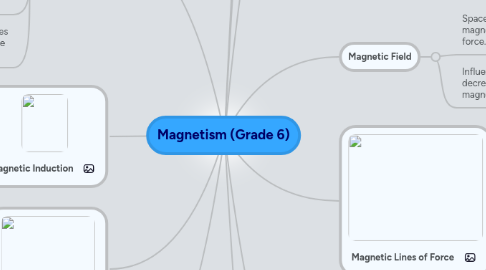
1. DOMAINS
1.1. Inside a piece of Steel, there are large number of Tiny Magnetized regions called DOMAINS
1.2. In Un-magnetized steel the magnetic domains are jumbled i.e. are in different directions.
1.3. Stroking steel with a bar magnet, magnetizes the steel which pulls the domain in the same direction.
2. Magnetic Induction
2.1. Phenomenon by which a magnetic material acquires magnetic properties Temporarily, when placed in magnetic field of another magnet.
3. Magnetic Keepers
3.1. A piece of Iron is placed across the poles of Magnet to prevent it loosing its magnetism.
4. Demagnetisation
4.1. Magnet can lose magnetism if stored by itself i.e. without a Keeper.
4.2. A magnet can loose its magnetism if it is:
4.2.1. Hammered
4.2.2. Heated
4.2.3. Dropped from heights
5. Magnetic substance when in touch with a Magnet, temporarily get the magnetic properties.
5.1. e.g. Pin in touch with a magnet, attract the other pins
6. Properties of Magnets
6.1. Attractive Property
6.1.1. Magnets attract metals like Iron, Steel, Nickel, Cobalt
6.2. Directive Property
6.2.1. A freely suspended Magnet always points in the North
6.3. Like poles repel and Unlike poles attract each other.
6.4. Poles exist in pairs
7. * Points
7.1. Phenomenon of Magnetism was described by Greek philosopher - THALES
7.2. Lodestone / Magnetite
7.2.1. Naturally occurring Magnet
7.3. First use of Magnet was for Compass
7.3.1. Ancient Chinese were the first to know the Directive Property of Magnets
7.4. Magnetic Substance
7.4.1. e.g. Iron, Steel, Cobalt, Nickle
7.5. Non-Magnetic Substances
7.5.1. Plastic, Paper, Wood, Rubber, Copper
7.6. Directive Property
7.6.1. Poles
7.6.1.1. Pole pointing towards North is the - North Pole
7.6.1.2. Pole pointing towards the South is the - South Pole
7.7. Test of Polarity
7.7.1. If an object is repelled by magnet then it must be a magnet, since only like poles of two magnets repel.
7.7.2. Repulsion is the sure test for Polarity of a Magnet
7.8. Poles exist in pairs
7.8.1. If a magnet is broken into pieces - Each piece remains a magnet with North and South Poles
7.9. Magnet Strength
7.9.1. Power of magnet for attracting is not uniformly distributed. The regions near the ends (Poles) attract more strongly than the middle portion.
7.9.2. If the magnet is cut into two exactly 2 pieces, then the strength of each magnet is exactly half (1/2) of the original magnet.
7.10. Earth's magnetic field is due to electric currents generated in its molten core due to its rapid spinning .
7.10.1. believed
8. Magnetic Field
8.1. Space around a magnet around which any magnet or certain metals experience a force.
8.2. Influence of Magnetic force decreases with distance away from magnet
9. Magnetic Lines of Force
9.1. Lines are crowded near the Poles, where the field is the strongest.
9.2. Lines are far part where field is weak
9.3. Lines start from North poles and end at South Pole.
9.4. Lines do not intersect i.e. cross each other
10. Types of Magnets
10.1. Natural Magnets
10.1.1. Lodestone/Magnetite
10.1.1.1. Do not have very strong Attractive or Directive properties.
10.2. Artificial Magnets
10.2.1. Piece of Iron when rubbed by Lodestone, acquires properties of magnetic lodestone.
10.3. Permanent Magnets
10.3.1. Certain types of Iron, once magnetized retains the magnetism for long are called Permanent magnets.
10.3.2. Made up of Steel or mixtures of Iron, Nickel, Cobalt and other substances.
10.4. Temporary Magnets
10.5. Electromagnets
10.5.1. A magnet in which magnetism is produced because of the flow of current passed through coiled wires around its metal core.
10.5.2. Strength of Electromagnets can be increased by:
10.5.2.1. Increasing number of turns of wire coils
10.5.2.2. increasing the power supply
11. Shapes and Uses of Magnets
11.1. Bar Magnet
11.1.1. Fixed on doors or on lid of boxes
11.2. Horse Shoe Magnet
11.2.1. Used in electric Motors or Electronic Tubes
11.3. Circular Magnet
11.3.1. Used in Electronic Computers
11.4. Cylindrical Magnet
11.4.1. Used in certain machines to hold the objects in position.
11.5. Electromagnet
11.5.1. Used in Household appliance - Refrigerators, Vacuum Cleaners
11.5.2. Separate and lift Iron and Steel Objects from among wastes
